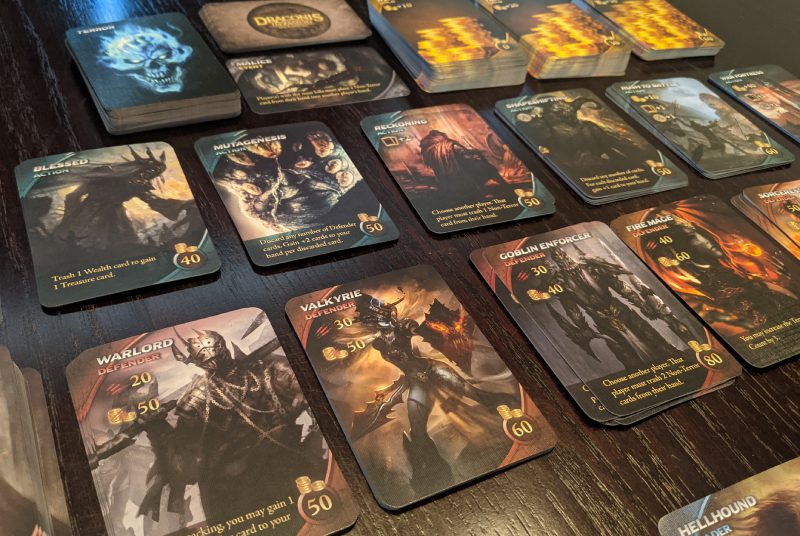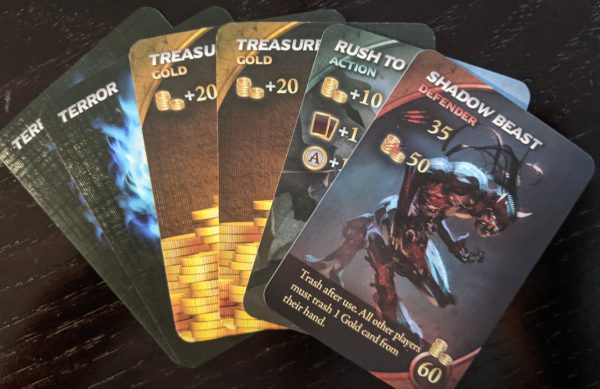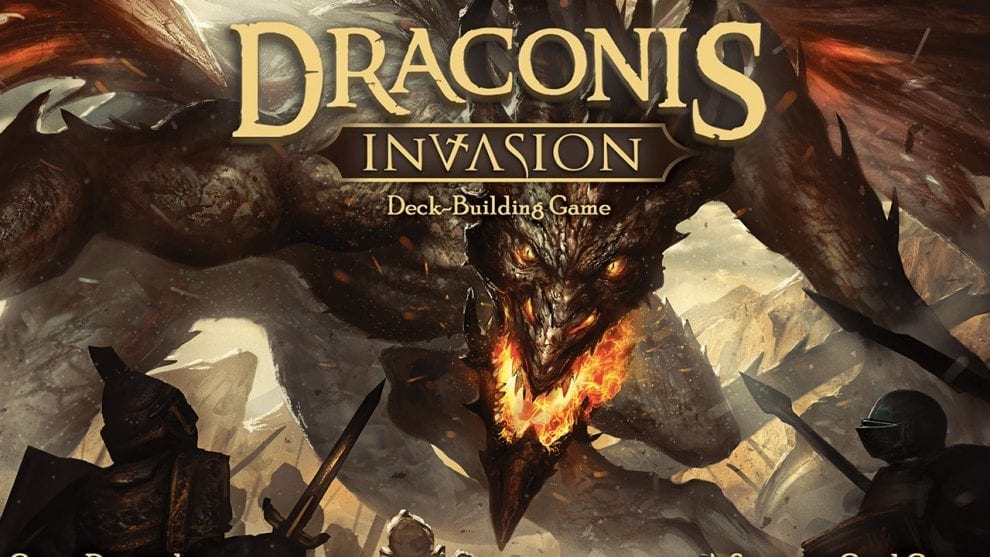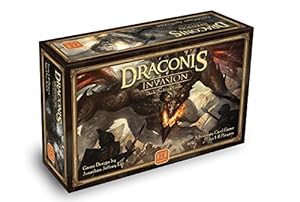Disclosure: Meeple Mountain received a free copy of this product in exchange for an honest, unbiased review. This review is not intended to be an endorsement.
About five years ago, I wrote a review on the original Draconis Invasion. It was a long, detailed, and incredibly dull review yet I concluded it was one of my favorite deckbuilders. I played the game about forty times before liquidating it from my collection, so I wasn’t exaggerating my enjoyment of the game. Now in 2021, a new expansion comes along and it’s time to visit this game once again. I guess you can say that this is the Evil Dead 2 of game reviews since this is both a sequel and a remake.
With a name like “Draconis Invasion” slapped onto the box, there isn’t much to explain here. There is an invasion of monsters like Dragons, Necromancers, and Hellhounds trying to overrun a nameless kingdom. To accomplish this, you must use your hand picked Defenders to drive them back. While this sounds like a concept for a cooperative game, it is a competitive experience.
Keeping It Old School
This is a deckbuilder, and it loves to stick close to tradition. Your starting cards are terrible and throughout the game, you will buy more cards to improve your deck. As for the game flow itself, it is quite simple. You draw a hand of six cards and you go through the A-BCDE-F system. After going through the letters, you discard your hand and draw six cards from your deck for the next turn.
A stands for Action. There are several teal Action cards, and if you have one in your hand, you can play it. Action cards are your typical “follow the words on the card” that is this genre’s trademark.
After Action, you’ll notice the block of letters of BCDE. These are four moves, and you can only do one of them. B is for Buying, which means show your gold cards and buy a single card Action or red Defender card from the market. C is Campaign, and this allows you to draw two Campaign cards. Campaign cards are end-game bonuses for hunting specific monsters. D is Defeat, using your Defender cards to defeat one monster. Finally, E means Eliminate, enabling you to remove from your deck one non-Terror card from your hand.
F is the last move you can do, and it means Forward. If you have any unused gold cards after picking one of the four previous moves, you can place one of them on top of your deck. This will ensure some stability and it’s a great tool to use when you draw too many gold cards, or you have a terrible hand.
While there are a bit more rules to explain, I do appreciate this clear approach. It’s a simple game to learn since the flow is logical and straightforward. With player aids explaining all the letters, I would consider Draconis Invasion as one of the easiest entry-level deckbuilders out there.
Hire A Professional, Not A Hero
With that out of the way, let’s talk about monsters. You have a row of blue easy monsters and gold hard ones. Each of them will have a health, victory point value, and a reveal effect. Using your Defeat move, you will play your Defender cards and add their damage together, but with a small twist: every Defender card has a gold cost to play it. Now you are not only thinking about the upfront cost, but you are considering the odds of actually playing the Defender when it is in your hand.
After defeating a monster, you will immediately draw a new one and read its Reveal effects. This is a “nasty stuff happens to you” type of deal, such as forcing you to draw fewer cards in your next turn. Most of the time, you will end up gaining Terror cards.
These blue skulls are the most controversial feature in Draconis Invasion. Don’t know why, but plenty of negative reviews simply dislike it, and this confuses me because this isn’t a new idea. Terror cards are junk cards and they do nothing but clog your deck. The change here is each Terror card that goes from your hand to your discard pile increases the Terror count by 1. Once that count reaches 6, you draw an Event card, and the next Terror card resets it back to 1.
Similar to the Reveal effects, the Event cards also inflict pain, but only on those who have killed the most monsters. Although this may appear to be an artificial way to attack leading players, there is a reason behind it.

Everything Has Rhythm
Draconis Invasion isn’t a game about building the best deck possible. It’s about creating the right deck to match the tempo. That’s going to require some explanation, so let me crack my knuckles here before I continue.
The game ends in two conditions: The event deck runs out, or someone has slain six monsters. Many first-time players will often go for the weak blue monsters since you can defeat some of them with your starting cards. Thanks to the Event cards, a tactic such as this can’t be viable in the long run.
Terror cards fill this role, but they also serve another purpose. A common tactic in deckbuilding is to buy cards and slim down your deck to the point that you can cycle through your favorite cards in a short time. Because Terror cards clog up the deck, slim decks suffer, and if you cycle your deck quickly, you cycle through Terror cards, thereby forcing you to deal with a whirlwind of Event cards that impact you and you alone.
Draconis Invasion holds an unusual appeal for me because of this attention to pacing. Other deckbuilders give you all the time in the world to build the deck you want while Draconis Invasion squeezes you like lemon on a hot summer Tuesday. Due to its strict turn structure, every turn requires you to sacrifice opportunities, such as buying a single card instead of defeating a monster. You also start with two Campaign cards, which guide your gameplay styles such as an economic deck with a few hyper-strong Defenders or a small army of weak Defenders smashing the game clock.
Resurrecting The Ancients
Some of you might notice that Draconis Invasion sounds like an average deckbuilder, maybe even dare calling it a Dominion clone. To some extent, it is, and I don’t view this as a problem. Not every single game must be “innovative” to be enjoyable. I prefer to pick the brain of the designer, see what type of experience they want to create, and Draconis Invasion is obviously aiming for an HD remake of an old deckbuilding game.
However, no matter how much I love these mechanisms, what makes a deckbuilder complete is the powerful abilities of its cards. Unfortunately, the cards in the Draconis Invasion base game barely explore its own system. It sticks too close to the deckbuilder genre tropes, such as drawing two cards or discarding cards in your hand then drawing more. Even the Event Card barely goes beyond forcing discards or gaining more Terror cards.
It is good enough for people starting out in the deckbuilding genre but inadequate for the experienced. Draconis Invasion has sand between its toes, yet it isn’t brave enough to explore the oceanic depths. With the Wrath expansion, the game has finally gained the courage to go for a swim.

Going Through The Stages
The Wrath expansion is a “more stuff” type of expansion, meaning more Monsters, Events, Actions, and Defenders. There are no new rules here.
Opening the box reveals something strange. Instead of shrink-wrapped cards, they are packaged as “stages” because this is a campaign. No, it isn’t a legacy. It doesn’t even have a winner in the campaign. You don’t even have to play with the same group.
There are twelve stages, with each having its flavor text, a fixed market setup, and rule modifiers. Players are fed with new content through these stages, rather than having the game flood your group with content as if a dam just blew up.
I’ll admit I was a little confused at first, yet I can see the purpose here. I don’t have to play with the same group, there is no backlog of rules to memorize, and I can even teach new people the game without compromising the campaign progress. It’s weird, but it works.
So the big question is, how are the new cards? Good. Damn good. Triple good. Alright, that’s enough.
Sword Fighting In An Outhouse
The theme behind this expansion is more player engagement in every area. Defenders, Actions, and Event cards now have a slew of effects that interact with your opponents. Some are good, while many of them are quite mean. There are some cards that are so bizarre and absurd that I find it surprising that they are here, yet none of them feel broken.
The first clear sign of these new changes are the starting Defender and Action cards. In the base game, the “Casualty of War” Action card and “Imperial Guard” Defender card was always available to purchase. Imperial Guard only did five damage, while Casualty of War allowed you to trash a non-Terror card from your hand. The expansion now replaces these two with “Sacrifice” and “Centurion” cards. Sacrifice does trash a card, in addition to having to pick another player. They can also trash a card if they choose, which greatly increases the pacing. The Centurion cards now give you a bonus gold card if you use a pair of them to defeat a monster, tempting you for those early kills for that two-for-one special.

Additionally, there are plenty of other effects that make use of the various systems in Draconis Invasion. Some Defender cards force a player to trash a card in their hand or an Action card that utilizes the Terror cards in your hand for an advantage. There are Defender cards with victory points so you don’t have to concentrate so much on the monsters. Cards with powerful abilities are often trashed immediately after use. There is a lot more player interaction here, some of them being cruel enough for Disney to make a spinoff movie to justify it. I will say that there is a bit more randomness here as well, and deckbuilder purists might get turned off.
As far as the Wrath expansion is concerned, I can definitively say that Draconis Invasion now has its own identity and would even dare say it’s essential for the veterans of the genre. The expansion gives the game a unique feel compared to its peers while still keeping a sense of familiarity with old-school deckbuilders. In every respect, it is commodifying nostalgia, and it is an admirable example of a game revisiting a decade-old design and making it work.












I’ve just bought this game and its expansion based on this review.
Thank you (..?)
…I hope.
But seriously, regardless if I’ll end up liking it or not –
This is a great review.